After spending two years in China with Dalian Professional, Rafael Benitez returned to the Premier League as he signed a three-year contract with Everton. After eight games, they had 14 points, just one behind the top-four.
Benítez believed the attacking performance was more about the quality of players, but the defending was more workable. He wanted to see Everton defending as a team, being strong, with intensity and took the momentum to become a solid side. With some very clear defensive principles being introduced to the players, the Toffees became a tough team to beat. They showed great character at Old Trafford and Turf Moor, where they conceded first but came home with four points in total.
This tactical analysis will break down Benítez’s defensive tactics into details, and it shows the principle of plays that transformed the defence of Everton.
Midblock & side traps
Everton had a PPDA of 13.48 this season, which was the seventh high in the Premier League and suggested their pressing were not high. However, they had the third-lowest xGA at 8.64, even lower than the likes of Liverpool and Chelsea. The Toffees were also quite impressive in several other defensive metrics, their defensive duels won % (61.3%) and aerial duels won % (47.8%) were both above the mean, while they had 47.21 interceptions per 90, more than any other teams in England’s top-tier football league.
But how exactly they defend on the pitch? This analysis will use some in-game examples to illustrate the defensive principles of Benítez.
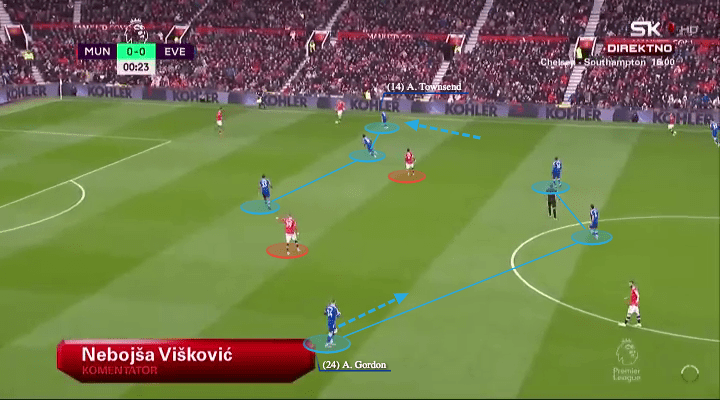
The midblock shape of Everton can vary from a 4-2-3-1 to a 4-4-2, or even a 4-3-3, just depends on how you interpret the formations, the most important must be the defensive principles. No matter from a collective or an individual perspective, you could see Benítez transformed the team by giving clear instructions.
Against opponents that played out from the back with two defensive midfielders, such as the 2-2, 3-2, or 4-2 shape, Everton would try to set a 4-4-2 midblock by using two strikers to cover the two opposition midfielders. In this example against Manchester United, Scott McTominay and Fred were under the first line’s shadow so they could lure the attack to wide spaces.
Then, the wingers must take action. On the ball flank, the winger should step up to close the receiving wide player as Andros Townsend did above, while the far side winger (Anthony Gordon) should go into the centre to maintain compactness. The formation went from a 4-4-2 to a 4-3-3.
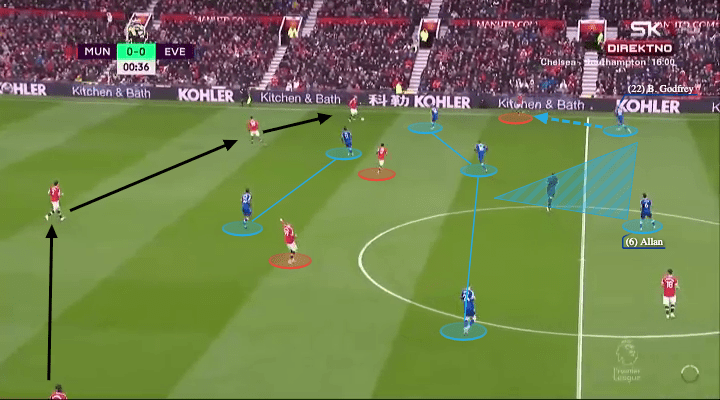
The principles of Benítez were very clear. He allowed the opposition to play around them, from side to side, but not into or through the block. Therefore, it was important to block central access and force the ball out wide, where they could use a side trap and the touchline to bound the opponents.
United were circulating the ball in the above situation, all the way from Aaron Wan-Bissaka to Luke Shaw. However, no matter how they passed laterally, Everton players were patient to stick together in a unit instead of stepping up.
It was a 4-1-3-2 shape from the Toffees as Allan was slightly deeper (this was another tactical concept which we would explain later). On the ball side, as Townsend went higher to approach Shaw, when Anthony Martial dropped, the Everton full-back: Ben Godfrey must stick tightly to make sure the winger could not turn. If United go into the trap, it was a challenging opportunity to recover possession. If not, then, just stay in shape to block the centre and let them play around.
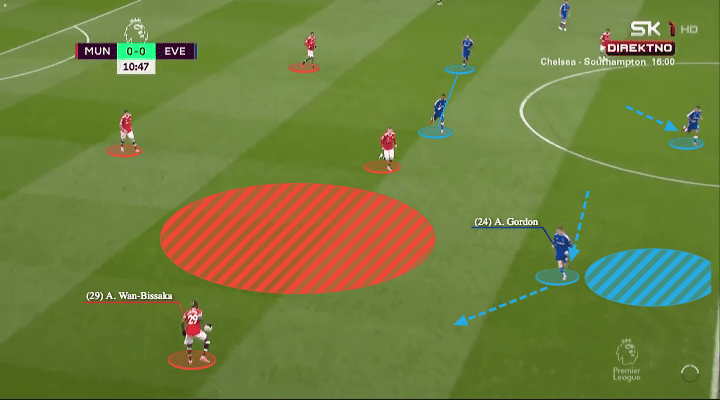
Here, we can have a better angle to analyze the specific instructions on how the wingers defended the wide spaces. Initially, they must stay narrowly in the half-spaces to block this channel, so the opponent would not play vertically to break the lines. Then, when the ball went sideways, it was the winger’s trigger to press.
The angle of the press was vital too. You could see Gordon’s running path, he went a bit lateral to cover blue spaces before going diagonally towards the strong foot of Wan-Bissaka. That means the red space was without protection, United could exploit by the right-back’s ball carrying or a pass to Harry Maguire/McTominay.
But this was exactly the principle of defence! Do not let the opposition play through/into you, so the blue space must be closed. Contrarily, even United could have more spaces to play in zone red, they were still outside of the block and no progression was made.
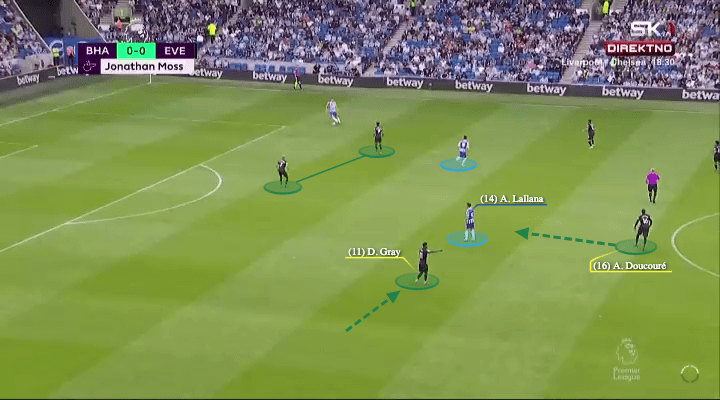
There was another very similar example against Brighton, Graham Potter’s team flexibly adapted with one or two number six in the game. On the above occasion, the Seagulls’ midfielders were slightly asymmetrical as Adam Lallana was slightly higher, so it was a bit more difficult for the striker to cover. However, Benítez’s men knew what to do clearly, the ball far winger: Demarai Gray and Abdoulaye Doucouré both oriented themselves towards the former Liverpool midfielder to limit that space.
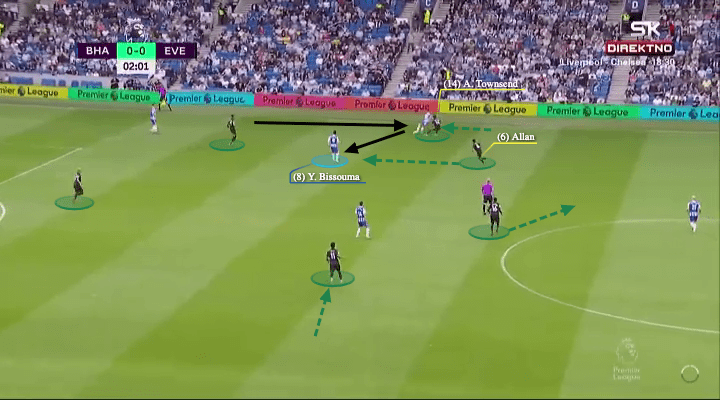
Not letting the opposition midfielder to play behind the Everton strikers was always a top defensive priority of the team. If he received, the Toffees must react instantly and press him. Here, even Townsend closed the wing-back, Brighton managed to find Yves Bissouma, so Allan must press him vertically to force him play.
The discipline of Everton’s defence should be praised too, the players all adjusted positions according to the situations. The left-winger went into the centre to close Lallana, which free Doucouré to cover Allan in the central third.
Wide defending, pressing & cover
As suggested above, Everton liked to lure the opposition to the wide spaces. From there, very clear defensive principles must be applied to each individual so they would not be too passive. Even defending in deeper areas, Benítez insisted the team must keep the intensity to apply continuous pressure to the ball.
In this part of the analysis, we will go into detail to dissect their wide defending concepts one by one.
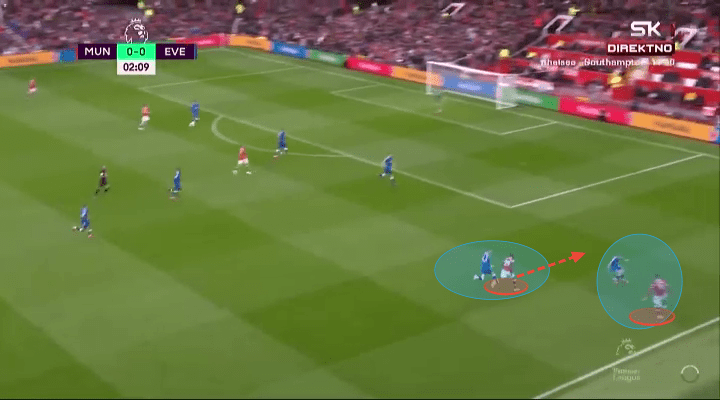
In the first scenario, United had two attacking players on the wing, which was often seen from teams playing with wingers and full-backs. Usually, Benítez did not prefer his player shifting the defensive duties, hence, they would defend a man-oriented manner. When Lucas Digne pressed Mason Greenwood, the left-winger (Gordon) must track Wan-Bissaka tightly, so they contained the opposition in this 2v2.
But this was not the only way to defend, football is a dynamic sport and there were many more possible scenarios.
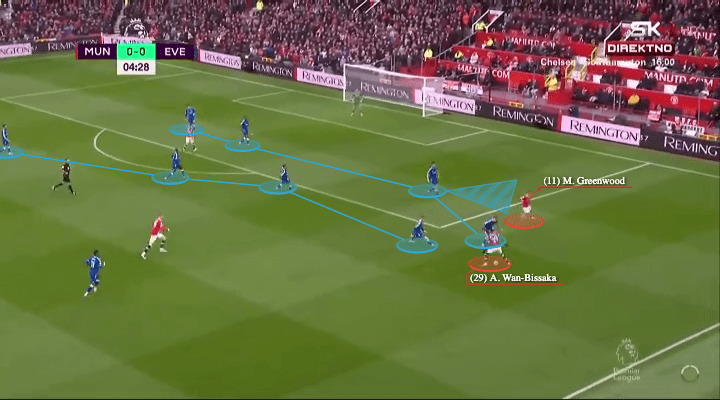
Winger and full-back defending man to man was not the only option. Apart from that, you can choose to double-press the ball as pressing from two angles gave a greater chance to recover possession.
On the above occasion, the Everton left centre-back was out to cover, so Digne oriented himself towards Wan-Bissaka. In this situation, the left-winger should not be standing and watching, even there was no run to track, he must defend together by helping his left-back. It would become a 2v1 on Wan-Bissaka or a 3v2 out wide so Everton could press with a numerical advantage.
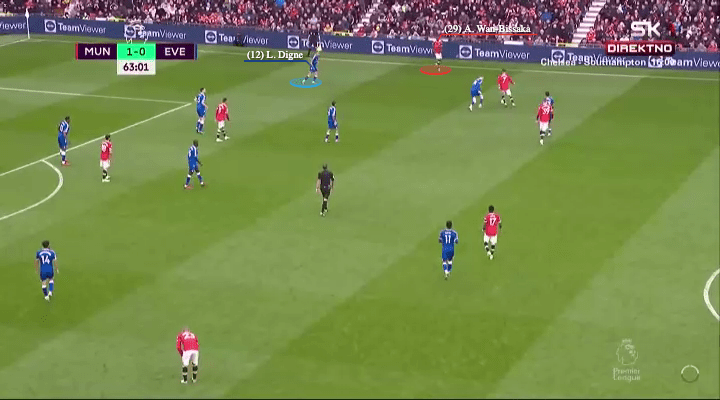
Another aspect we show is the individual defending. When should the full-back step up, and when he pressed, what is the expected distance between the pressing player and the receiver?
Firstly, the full-backs must be staying close to the centre-backs initially, or else the opponents would play through them in the half-spaces. But when the ball went wide, he should immediately step up to limit the space of the wide player or even closing his stronger foot, depending on the context.
Let’s see Digne’s position in the above situation, which Wan-Bissaka was yet to receive from Cristiano Ronaldo. Then, compare it to the next image.
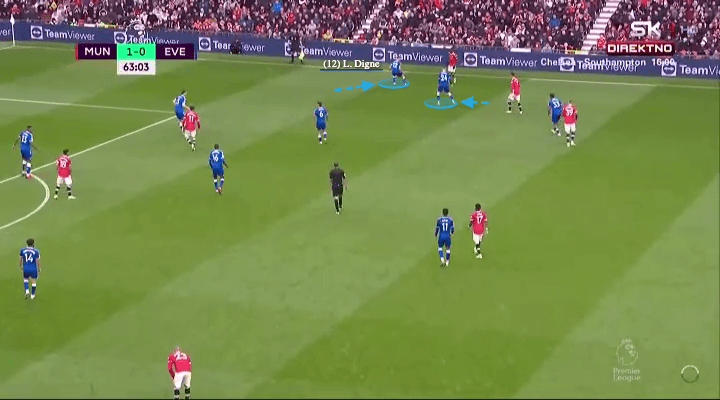
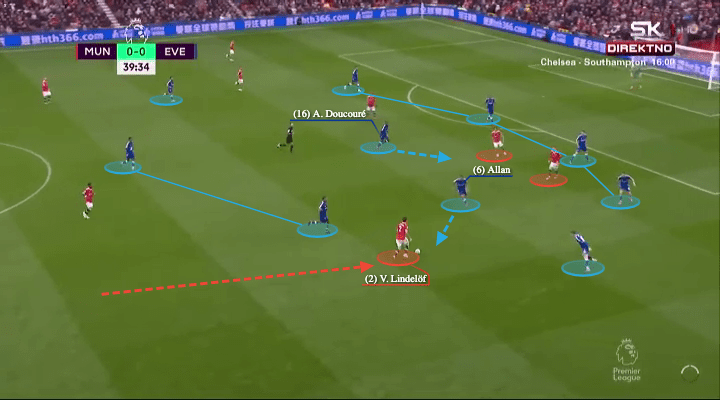
The wide defending was not only about individual defending. Of course, what Benítez wanted to see was the team spirit, as his Everton must defend together and help each other out. From here, we would explain the collective defensive principles. The Toffees were very impressive in terms of “pressing and cover”, you could always observe the coordinated defensive behaviours between midfielders. When one went out to press, the other must drop a bit to cover and offer protection to spaces in front of the centre-backs.
In the above situation, Victor Lindeløf drove forward with the ball and bypassed the strikers. Allan was forced to step up, but then, simultaneously, Doucouré must diagonally shift to cover spaces behind Allan. It was of the essence to close the ball side, and limit the rooms of players between the lines. Therefore, the last line should not be too deep as well, as they need to close those vertical spaces between the lines with the midfielders.
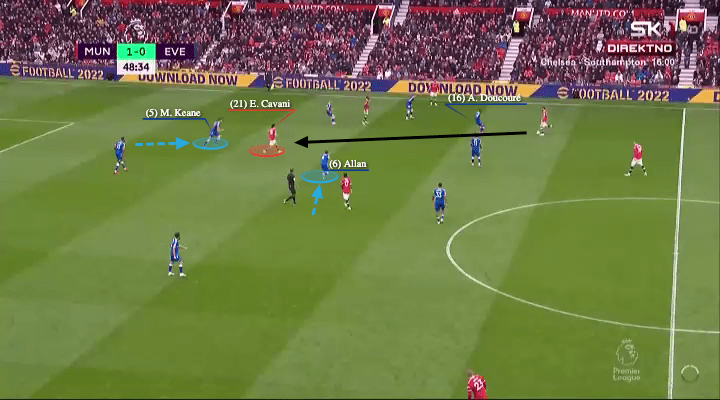
Another situation here. The United right centre-back drove forward again and Doucouré went up to block him, then, Edinson Cavani appeared in spaces left by Doucouré. Lindeløf was a good ball-playing centre-back and he managed to play vertical to find his Uruguayan teammate. Michael Keane wanted to step up, but he was not good at defending spaces in front.
Now you can sense the importance of Allan’s cover. The Brazilian midfielder was in an alternative horizontal space compared to Doucouré, and he pressed Cavani from the centre to push him towards the sideline. The angle of the cover was good, but it must be attributed to the initial positioning and the awareness to cover partner.
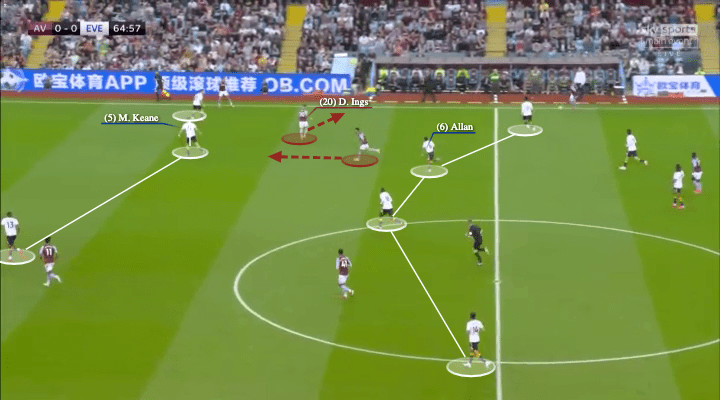
With this framework, you could analyze their conceded goal against Aston Villa. In Matty Cash’s opener, the midfielder lost their “pressing and cover”. When Danny Ings escaped from Keane’s and Digne was occupied, Allan neglected the deep runs of midfielder went out to press.
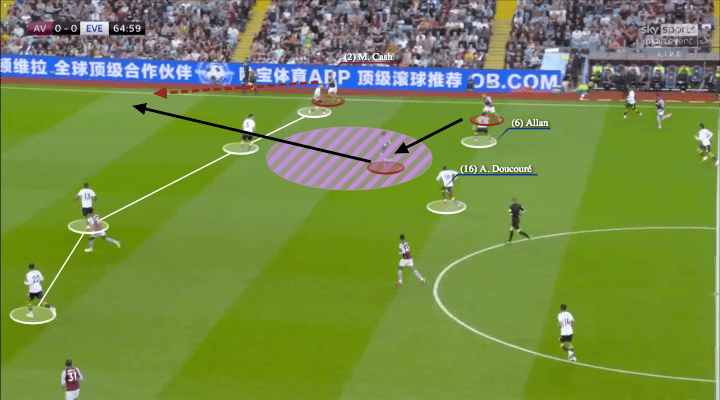
But then they were unable to close the purple space as Doucouré stayed in a parallel position with Allan. Since the Brazilian was slightly late on Ings, he could not close the angle of a central pass, and the attack was too quick, his partner was yet to reach that space. Without the centre-back stepping up, they were easily exploited by Villa and Cash scored.
Low block & defensive line
Then, we can also look at the low block defending and the defensive line behaviours of Benítez’s Everton. Some were very similar to the midblock, but we can focus more on how the defenders were helping each other out.
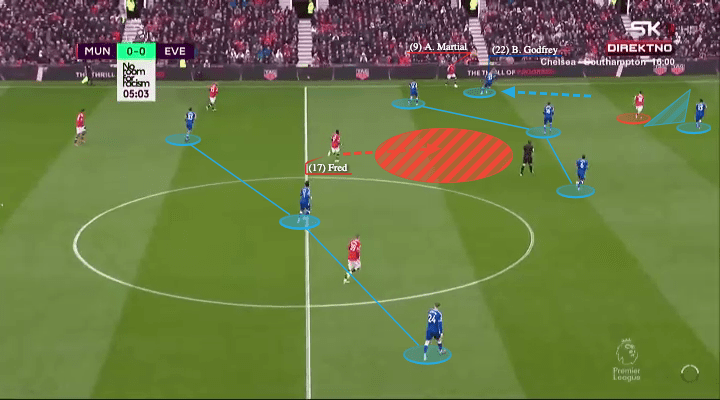
The first image shows a situation similar with the wide defending, but Everton were compact. They had so many players on the flank, and it was an insane 5v2 situation around the ball. At Benítez’s Toffee, the full-backs must be aggressive to step up and close the wide space, and the centre-back must cover, while two midfielders moving towards the ball to close the centre. It would be even better if the winger could drop back a bit to approach the wide player from a higher angle, so there was a potential double-press situation.
But Everton were particularly vulnerable behind the first line as the striker was late to fall back after the initial press. For example, Fred could easily access the red space, which gave United a lateral passing option in the centre. But comparatively, showing the red space was better than allowing United going into spaces in front of the centre-back.
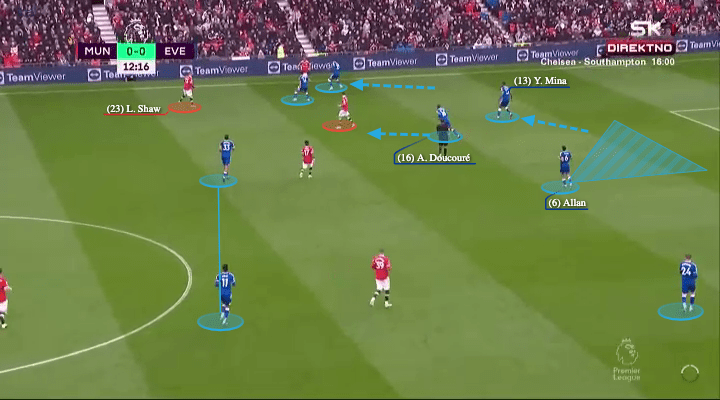
The next example shows the defensive line behaviours of Everton. When United were attacking from the flank with the winger on the ball, Everton’s winger and full-back both closed his angle down. This was the wide defending concept we have introduced above.
Then, as suggested, the ball near centre-back must move laterally to cover the full-back, but the ball far centre-back might not be shifting together. If the last line moved to one side, they might concede a clear-cut opportunity when the opponent sent the ball to the opposite half-space. To close that gap, Benítez preferred the “covering midfielder” (Allan) to drop a bit deeper, so his job was to check the gap and support the “pressing midfielder” (Doucouré).
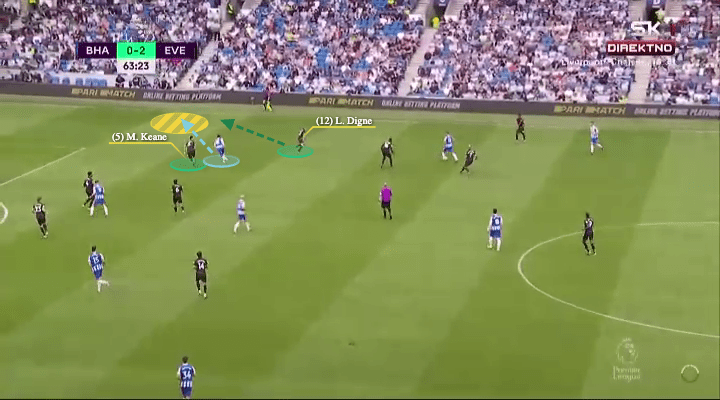
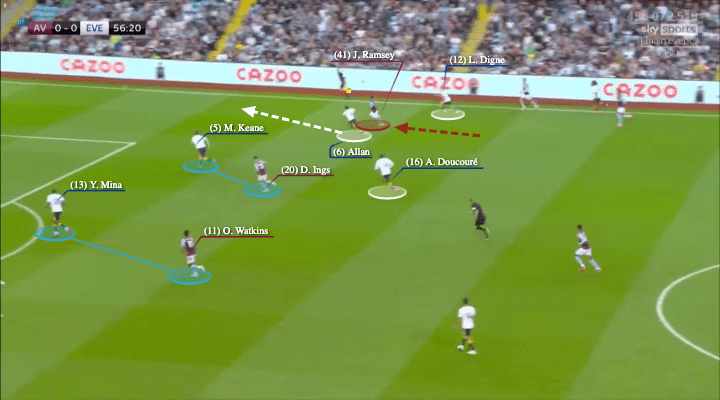
Intriguingly, the defensive line behaviours were not dogmatic as it sometimes depended on the opposition. Against Villa, a team that was more vertical, aggressive, and quick in the attack, there was less time to shift in the defence. Also, Dean Smith’s men had two strikers to occupy two centre-backs, so it was unwise to instruct the centre-back to cover the full-backs.
So, in that game, the Everton defensive midfielders had a slightly defensive duty. As indicated in the above image, when Jacob Ramsey made the forward sprint, Allan tracked the run tightly to make sure the opposition could not receive freely in zone 18.
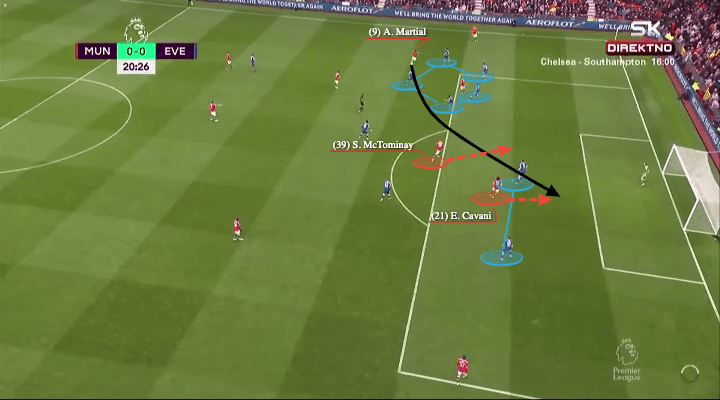
But the five-man defending group also had it weakness. As the defence of Everton swung to the flank, relatively, they conceded big spaces in the centre and the remaining defenders were isolated. They conceded a chance to United because of this structure.
When Everton did not stop Martial drifting inward, the Frenchman international whipped in a cross and the Toffees were very exposed in the penalty box. Since the five-man group was defending on the ball flank, there was only two defenders remaining. United very easily created separation and isolation through McTominay’s deep run to free Cavani.
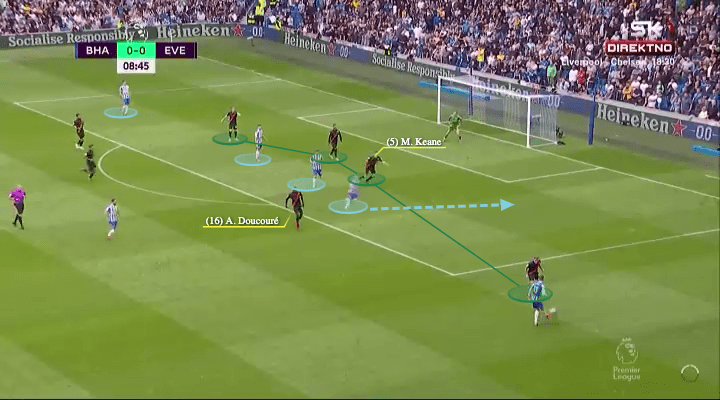
Back three
Although Benítez played his Everton in a back four for most of the time, intriguingly, there was an exception. In the away game against Burnley, the Spanish head coach made specific adjustments to adapt to his opposition, it was interesting to see why.
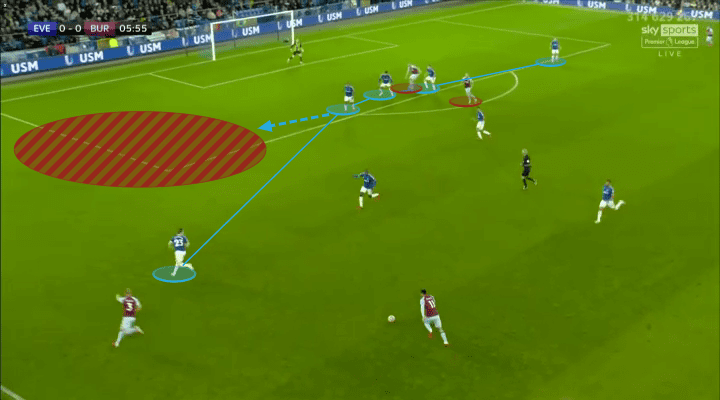
The answer was a bit obvious maybe, everyone knows Sean Dyche’s team was going to play a strict 4-4-2, conventional English football, direct, physical, a lot of aerial duels, many crosses. Given each Everton centre-back was not particularly strong at defending in the air, Benítez wanted to have a “3v2” advantage over the two-striker system of Burnley. It was safer to defend with a “+1” numerical superiority at the backline and they could avoid isolation.
On the above occasion, you could see Everton’s 3v2 advantage in the centre, the centre-backs were close to each other so their spaces to defend was smaller. Of course, the wide centre-back still need to cover the wing-back/red space if necessary, but the priority was to keep an eye on the strikers.
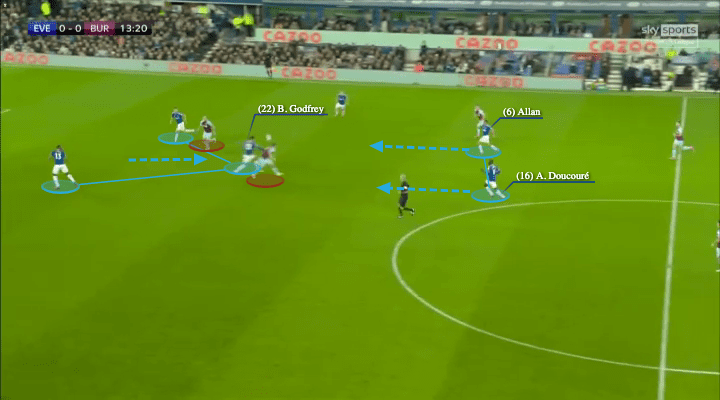
The setup also helped Everton to control the second ball too. As it was a 3v2, Benítez’s men could avoid isolation as there was always an additional centre-back to cover his partner. Hence, each of them has greater freedom to stick with the striker nearby, such as Godfrey attempting the duel in the above image.
Meanwhile, although the two-man midfield might be pulled out to defend higher spaces initially, they had very good awareness to drop back when Burnley played long. Then, this became a good defensive condition as they fought for the second ball from two angles.
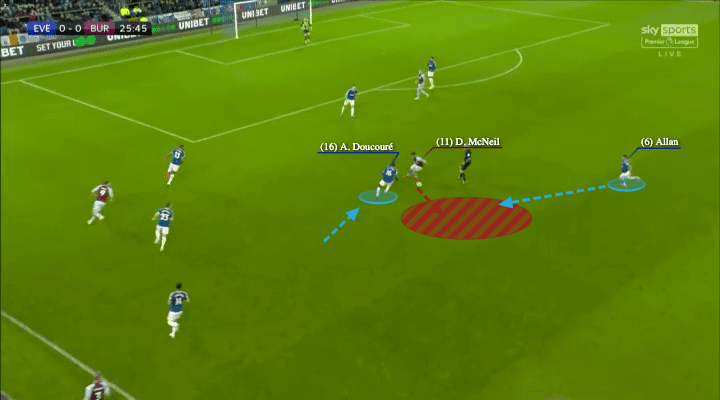
Conclusion
Apart from the defensive principles mentioned above, another great impact of Benítez was the confidence given to the player. Under the Spanish head coach, surprisingly, the likes of Gray and Townsend shined again, you can read more from this analysis by our fellow analyst: David Seymour.
Benítez is an experienced coach and a great asset to Everton. The season still has a long way to go and let’s see whether the Toffees could keep improving, especially against teams attacking with three at the back.





Comments